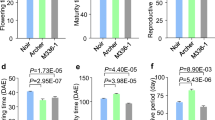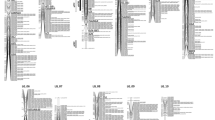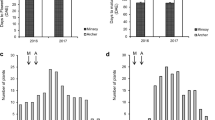Abstract
Flowering time is an important factor that controls crop yield and latitudinal adaptation. Soybean is a facultative short-day (SD) plant, and cultivars that originate from temperate regions generally undergo a very short juvenile phase and early flowering when grown in low-latitude regions, thereby resulting in extremely low grain yield. However, introduction of the long-juvenile (LJ) trait, which extends the vegetative phase and improves yield under SD environments, has largely overcome this constraint and has enabled the expansion of soybean production to tropical regions. Quantitative trait locus (QTL) mapping is a fundamental approach to the identification of new loci related to LJ trait, while conventional strategy takes lots of time to verify the findings. Here, we provide a new strategy to rapidly identify consistent novel QTLs by using multiple genetic populations and genotyping-by-sequencing (GBS) approach. In this study, we developed six F2 populations and grew them under SD conditions. A total of seven QTLs related to the LJ trait were identified by integrating flowering time (R1) and high-density genetic maps. There were three consistent QTLs repeatedly detected in different populations and one of them has been previously reported, yet two are novel. This research not only provides fundamental resources for fine-mapping candidate genes associated to the LJ trait, but also provides new insights to QTL mapping.

Similar content being viewed by others
References
Bernard RL (1971) Two major genes for time of flowering and maturity in soybean. Crop Sci 11:242–244
Bonato ER (1999) E6, a dominant gene conditioning early flowering and maturity in soybeans. Genet Mol Biol 22:229–232
Buzzell RI (1971) Inheritance of a soybean flowering response to fluorescent-daylength conditions. Can J Genet Cytol 13:703–707
Buzzell RI, Voldeng HD (1980) Inheritance of insensitivity to long daylength. Soybean Genet Newslett 7:26–29
Cao D, Li Y, Lu S, Wang J, Nan H, Li X, Shi D, Fang C, Zhai H, Yuan X, Anai T, Xia Z, Liu B, Kong F (2015) GmCOL1a and GmCOL1b function as flowering repressor in soybean under long-day conditions. Plant Cell Physiol 56:2409–2422
Cao D, Takeshima R, Zhao C, Liu B, Kong F (2016) Molecular mechanisms of flowering under long days and stem growth habit in soybean. J Exp Bot 68:1873–1884
Carpentieri-Pípolo V, de Almeida LA, de Souza Kiihl RA, Rosolem CA (2000) Inheritance of long juvenile period under short day conditions for the BR80–6778 soybean (Glycine max (L.) Merrill) line. Euphytica 112:203–209
Carpentieri-Pípolo V, de Almeida LA, de SKiihl R (2002) Inheritance of a long juvenile period under short-day conditions in soybean. Genet Mol Biol 25:463–469
Cheng W, Liu F, Li M, Hu X, Chen H, Pappoe F (2015) Variation detection based on next-generation sequencing of type Chinese 1 strains of Toxoplasma gondii with different virulence from China. BMC Genomics 16:888
Cober ER, Voldeng HD (2001) A new soybean maturity and photoperiod-sensitivity locus linked to E1 and T. Crop Sci 41:698–701
Cober ER, Molnar SJ, Charette M, Voldeng HD (2010) A new locus for early maturity in soybean. Crop Sci 50:524–527
Daverdin G, Johnson-Cicalese J, Zalapa J, Vorsa N, Polashock J (2017) Identification and mapping of fruit rot resistance qtl in american cranberry using gbs. Mol Breed 37(3):38
Fehr WR, Caviness CE, Burmood DT, Pennington JS (1971) Stage of development descriptions for soybeans, Glycine max (L.) Merrill. Crop Sci 11:929–931
Graham PH, Vance CP (2003) Legumes: importance and constraints to greater use. Plant Physiol 131:872–877
Hartwig EE, Kiihl RAS (1979) Identification and utilization of a delayed flowering character in soybeans for short-day conditions. Field Crop Res 2:145–151
Hazen SP, Schultz TF, Prunedapaz JL, Borevitz JO, Ecker JR, Kay SA (2005) Lux arrhythmo encodes a myb domain protein essential for circadian rhythms. Proc Natl Acad Sci U S A 102:10387–10392
Huang X, Feng Q, Qian Q, Zhao Q, Wang L, Wang A, Guan J, Fan D, Weng Q, Huang T, Dong G, Sang T, Han B (2009) High-throughput genotyping by whole-genome resequencing. Genome Res 19:1068–1076
Hymowitz T (1970) On the domestication of the soybean. Econ Bot 24:408–421
Jiang B, Nan H, Gao Y, Tang L, Yue Y, Lu S, Ma L, Cao D, Sun S, Wang J, Wu C, Yuan X, Hou W, Kong F, Han T, Liu B (2014) Allelic combinations of soybean maturity loci E1, E2, E3 and E4 result in diversity of maturity and adaptation to different latitudes. PLoS One 9:e106042
Kong F, Liu B, Xia Z, Sato S, Kim BM, Watanabe S, Yamada T, Tabata S, Kanazawa A, Harada K, Abe J (2010) Two coordinately regulated homologs of FLOWERING LOCUS T are involved in the control of photoperiodic flowering in soybean. Plant Physiol 154:1220–1231
Kong F, Nan H, Cao D, Li Y, Wu F, Wang J, Lu S, Yuan X, Cober ER, Abe J, Liu B (2014) A new dominant gene conditions early flowering and maturity in soybean. Crop Sci 54:2529–2535
Kong L, Lu S, Wang Y, Fang C, Wang F, Nan H, Su T, Li S, Zhang F, Li X, Zhao X, Yuan X, Liu B, Kong F (2018) Quantitative trait locus mapping of flowering time and maturity in soybean using next-generation sequencing-based analysis. Front Plant Sci 9:995
Li H, Durbin R (2009). Fast and accurate short read alignment with Burrows Wheeler transform. Bioinformatics 25:1754–1760
Li H, Handsaker B, Wysoker A, Fennell T, Ruan J, Home N et al (2009). The sequence alignment/map format and SAMtools. Bioinformatics 25:2078–2079
Li X, Fang C, Xu M, Zhang F, Lu S, Nan H et al (2017) Quantitative trait locus mapping of soybean maturity gene E6. Crop Sci 57:1–8
Liew LC, Hecht V, Sussmilch FC, Weller JL (2014) The pea photoperiod response gene sterile nodes is an ortholog of lux arrhythmo. Plant Physiol 165:648–657
Liu B, Kanazawa A, Matsumura H, Takahashi R, Harada K, Abe J (2008) Genetic redundancy in soybean photo responses associated with duplication of the Phytochrome a gene. Genetics 180:995–1007
Lu S, Li Y, Wang J, Srinives P, Nan H, Cao D et al (2015) QTL mapping for flowering time in different latitude in soybean. Euphytica 26:725–736
Lu S, Zhao X, Hu Y, Liu S, Nan H, Li X, Fang C, Cao D, Shi X, Kong L, Su T, Zhang F, Li S, Wang Z, Yuan X, Cober ER, Weller JL, Liu B, Hou X, Tian Z, Kong F (2017) Natural variation at the soybean j locus improves adaptation to the tropics and enhances yield. Nat Genet 49:773–779
Mandel MA, Yanofsky MF (1995) The Arabidopsis AGL8 MADS box gene is expressed in inflorescence meristems and is negatively regulated by APETALA1. Plant Cell 7:1763–1771
McBlain BA, Bernard RL (1987) A new gene affecting the time of flowering-maturity in soybeans. J Hered 178:68–70
Meng L, Li H, Zhang L, Wang J (2015) QTL icimapping: integrated software for genetic linkage map construction and quantitative trait locus mapping in biparental populations. Crop J 3:269–283
Mohan M, Nair S, Bhagwat A, Krishna TG, Yano M, Bhatia CR, Sasaki T (1997) Genome mapping, molecular markers and marker-assisted selection in crop plants. Mol Breed 3(2):87–103
Neumaier N, James AT (1993) Exploiting the long-juvenile trait to improve adaptation of soybeans to the tropics. Aciar Food Legume Newslett 18:12–14
Ray JD, Hinson K, Mankono JEB, Malo MF (1995) Genetic control of a long-juvenile trait in soybean. Crop Sci 35:1001–1006
Saindon G, Beversdorf WD, Voldeng HD (1989a) Adjusting of the soybean phenology using the E4 loci. Crop Sci 29:1361–1365. https://doi.org/10.2135/cropsci1989.0011183X002900060006x
Saindon G, Voldeng HD, Beversdorf WD, Buzzell RI (1989b) Genetic control of long daylength response in soybean. Crop Sci 29:1436–1439
Samanfar B, Molnar SJ, Charette M, Schoenrock A, Dehne F, Golshani A, Belzile F, Cober ER (2017) Mapping and identification of a potential candidate gene for a novel maturity locus, E10, in soybean. Theor Appl Genet 130:377–390
Spehar CR (1995) Impact of strategic genes in soybean on agricultural development in the Brazilian tropical savannah. Field Crops Res 41:141–146. https://doi.org/10.1016/0378-4290(95)00007-D
Upadhyay AP, Ellis RH, Summerfield RJ, Roberts ER, Qi A (1994) Characterization of photothermal flowering responses in maturity isolines of soybean (Glycine (L.) Merrill) cv. Clark. Ann Bot 74:87–96
Wang K, Li M, Hakonarson H (2010) ANNOVAR: functional annotation of genetic variants from high-throughput sequencing data. Nucliec Acids Res 38:e164
Watanabe S, Hideshima R, Xia Z, Tsubokura Y, Sato S, Nakamoto Y, Yamanaka N, Takahashi R, Ishimoto M, Anai T, Tabata S, Harada K (2009) Map-based cloning of the gene associated with the soybean maturity locus E3. Genetics 182:1251–1262
Watanabe S, Xia Z, Hideshima R, Tsubokura Y, Sato S, Yamanaka N, Takahashi R, Anai T, Tabata S, Kitamura K, Harada K (2011) A map-based cloning strategy employing a residual heterozygous line reveals that the GIGANTEA gene is involved in soybean maturity and flowering. Genetics 188:395–407
Xia Z, Watanabe S, Yamada T, Tsubokura Y, Nakashima H, Zhai H, Anai T, Sato S, Yamazaki T, Lu S, Wu H, Tabata S, Harada K (2012) Positional cloning and characterization reveal the molecular basis for soybean maturity locus E1 that regulates photoperiodic flowering. Proc Natl Acad Sci U S A 109:E2155–E2164
Xu M, Xu Z, Liu B, Kong F, Tsubokura Y, Watanabe S (2013) Genetic variation in four maturity genes affects photoperiod insensitivity and PHYA-regulated post-flowering responses of soybean. BMC Plant Biol 13:91. https://doi.org/10.1186/1471-2229-13-91
Zhao C, Takeshima R, Zhu J, Xu M, Sato M, Watanabe S, Kanazawa A, Liu B, Kong F, Yamada T, Abe J (2016) A recessive allele for delayed FLOWERING at the soybean maturity LOCUS E9 is a leaky allele of FT2a, a FLOWERING LOCUS T ortholog. BMC Plant Biol 16:20
Acknowledgments
We would like to acknowledge Mrs. Yafeng Liu for phenotyping and managing the file.
Funding
This work was funded by the National Natural Science Foundation of China (31725021, 31701445, 31801384, 31771815); the National Key Research and Development Program (2016YFD0100400 and 2017YFE0111000); the Strategic Action Plan for Science and Technology Innovation of the Chinese Academy of Sciences (XDA08030108); and the Open Foundation of the Key Laboratory of Soybean Molecular Design Breeding, Chinese Academy of Sciences (Y3ZK111001).
Author information
Authors and Affiliations
Contributions
FK designed the experiments. CF, SL, LC, HN, HL, TL, YT, ZH, LD, QC, XL, and XZ carried out the experiments. CF, LK, YL, BL, XY, ZH, and FK analyzed the data. CF, SL, and FK wrote the paper.
Corresponding authors
Ethics declarations
Conflict of interest
The authors declare that they have no competing interests
Additional information
Publisher’s note
Springer Nature remains neutral with regard to jurisdictional claims in published maps and institutional affiliations.
Rights and permissions
About this article
Cite this article
Fang, C., Chen, L., Nan, H. et al. Rapid identification of consistent novel QTLs underlying long-juvenile trait in soybean by multiple genetic populations and genotyping-by-sequencing. Mol Breeding 39, 80 (2019). https://doi.org/10.1007/s11032-019-0979-2
Received:
Accepted:
Published:
DOI: https://doi.org/10.1007/s11032-019-0979-2




